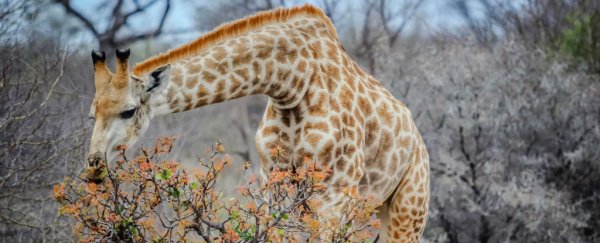If you thought we were pretty cluey about one of the most recognisable animals on the planet, you'd be wrong, because for more than two centuries now, we thought there was only one species of giraffe.
Turns out there are actually four, and they're as distinct from one another as a polar bear is from a brown bear. That means, as of today, the biology of the world's tallest mammal just got rewritten.
"This was definitely a surprise," lead researcher Julian Fennessy, co-founder of the Namibia-based Giraffe Conservation Foundation, told Maddie Stone at Gizmodo. "These [different species] split off 1 to 2 million years ago - that's huge. It's much larger than we expected."
Until now, giraffes were thought to belong to the one species, Giraffa camelopardalis, and within this species, they were split off into nine different subspecies, described according to certain population-based characteristics such as colouration and patterning.
But thanks to their research, Fennessy and his team now recommend that giraffes be split into four separate species:
- southern giraffe (Giraffa giraffa),
- Masai giraffe (G. tippelskirchi),
- reticulated giraffe (G. reticulata)
- northern giraffe (G. camelopardalis), including the Nubian giraffe (G. c. camelopardalis) as a related subspecies.
The discovery was made as a result of the first comprehensive genetic analysis of giraffes, conducted by the Giraffe Conservation Foundation and a team of German biologists over the past seven years.
The team collected 190 tissue samples from giraffes in Africa that belonged to the nine previously established subspecies.
After analysing seven different genetic markers and the mitochondrial DNA - DNA passed down from mothers to their offspring - of the tissue samples, they compared the results across the entire set. The differences across the samples revealed that there are actually four distinct types of giraffe - so distinct, that they don't appear to breed with each other in the wild.
While the discovery is exciting just in terms of correcting our own basic understanding of one of the world's most iconic animals, the conservation implications are huge.
The global giraffe population has declined from roughly 150,000 individuals across Africa 30 years ago to fewer than 100,000 today, thanks mostly to habitat loss. But because they were assumed to belong to the one species, their numbers were still enough to have them listed as "of least concern" on the IUCN Red List of Threatened Species.
This classification means giraffes have not been receiving nearly as much attention as African elephants and rhinos, for example, because everyone basically assumed they'd be fine for now.
But we now know that at least one species of giraffe, the northern giraffe (G. camelopardalis), has fewer than 4,750 individuals left in the wild, and the reticulated giraffe (G. reticulata) has less than 8,700 individuals.
"[A]s distinct species, it makes them some of the most endangered large mammals in the world," Fennessy told the press.
So, what happens now? Well, the team's recommendation of four separate species of giraffe will have to be approved independently to be made official, but once that happens, it's hoped that the conservation status of each species will be reviewed separately so we have a more accurate indication of the kind of shape they're in.
"If the findings of the current study are accepted, then it may well be that some species would be listed in threatened categories on the IUCN red list," the ICUN announced today. "This would hopefully flag the need for increased attention on a species that is otherwise normally considered common."
As to why it took us this long to properly investigate something as conspicuous as the giraffe, Axel Janke from the Senckenberg Biodiversity and Climate Research Centre and Goethe University in Germany, told BBC's Victoria Gill that they've been largely overlooked by science until now.
"We've clearly completely forgotten what a giraffe is," he said.
The research has been published in Current Biology.
